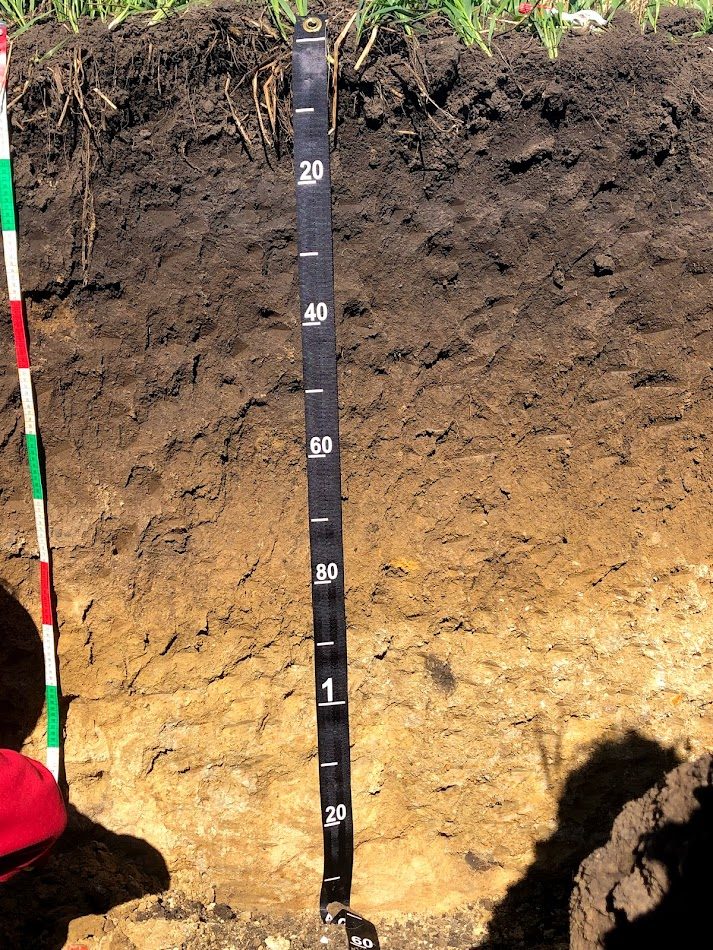Soil Order
Amber Anderson; Rich Pope; Lee Burras; and Erin Smeltzly
A soil order is the most broad category within the NRCS system of soil classification. There are 12 recognized orders, and each of these provides information about basic properties affecting soil management. For this contest, we will limit consideration to the following five soil orders that are found in Iowa. A sixth order, Histosols, is described but will not be used in contests. Contestants should select the first option that accurately describes the soil:
Vertisol
[from invert, turns, mixes or churns]
These soils are challenging to manage due to their high percentages of shrink-swell clay. In Iowa, they will generally be on flood plain or stream terraces, as water filled with fine particles pooled away from the river. As these high clay soils go through periods of wetting and drying, the clays expand and contract, resulting in large cracks that are then infilled with surface materials. This resulting soil “churning” can lead to tilted fence posts and uneven surfaces. These soils are challenging to manage due to their high percentages of shrink-swell clay minerals.
For the purposes of this contest, vertisols will be selected when the average clay content of the profile is 40% or higher (A and B horizon are “fine”), and evidence of shrinking/swelling is present or indicated (polished pressure faces on structural units, usually at roughly 45 degree angles).
Mollisols
[from mollis, or soft in Latin]
Mollisols typically have formed under prairie vegetation, adding significant organic material to depths beyond the surface layer. For the purposes of this contest, we will require 10+ inches (25+ cm) of moderately dark or dark materials (value and chroma less than or equal to three) and granular to subangular blocky soil structure. Image is a mollisol in central Iowa.

Alfisol
[from Al and Fe, the elements aluminum and iron (historic naming)]
In Iowa, these are regularly found in areas that developed under a native vegetation of trees. Alfisol soils have a significant clay accumulation in the B horizon, shown by clay coats on the edges of soil aggregates.
For the purposes of this contest, we will recognize soils with clear clay films as Alfisols. Clay films typically give individual soil aggregates a “varnished” look.
Inceptisol
[from incept, or a beginning]
These are developmentally young soils with weak development. They include a weakly developed B horizon (“Bw”) without a thick, dark A (under 10 inches, 25 cm).
For the purposes of this contest, an Inceptisol is a soil with an A horizon thinner than a mollisol and that has a B horizon, but without significant clay accumulation.

Entisol
[from recent]
These are under-developed soils, generally lacking a B horizon. Typically, Entisols occur where new deposits have not had time to weather or where erosion has removed the developing soil. If a soil does not meet any of the above soil order requirements, entisol should be selected.
For the purposes of this contest, these soils will have an A horizon underlain by a C horizon (no B).
For Reference: Histosols,
[from Histo-, or tissue]
These are soils composed primarily of organic rather than mineral matter; they occur in limited locations in Iowa. Organic material accumulates in areas that are usually wet year-round, where decomposition is limited from lack of oxygen. These materials are called either peat or muck. While they used to be more significant on Iowa’s landscape, extensive agricultural drainage has greatly decreased Histosol acreage as additional oxygen has increased decomposition of materials. Histosols will not be included in Iowa FFA soil contests but may be shown for educational purposes.
- The soil order is the most broad category within the NRCS system of soil classification and provides information about basic properties affecting soil management.
- Vertisols result from inversion, turn, or mixes in the soil. These soils commonly contain high percentages of shrink-swell clays.
- Mollisols are commonly formed under native vegetation and add significant amounts of organic matter beyond the surface layer.
- Alfisols develop under a native vegetation of trees and have significant clay accumulation in the B horizon, shown by clay coats on the edges of soil aggregates.
- Inceptisols are young soils with weak development. They commonly have a weakly developed B horizon without a thick A horizon.
- Entisols are under developed soils that lack a B horizon. These soils occur where new deposits have not had time to weather or where erosion has removed the developing soil.
- Histosols are soils composed of organic materials (peak or muck) rather then mineral materials. The organic material accumulates in areas that are usually wet year-round, where decomposition is limited from lack of oxygen.



